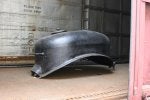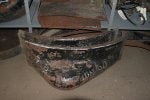Actually the PRR paint scheme was established as:
PAINT COLORS FOR PRR LOCOMOTIVES AND TENDERS As of October 8, 1929
DARK GREEN LOCOMOTIVE FINISH
*All Locomotive Wheels, *Trailer Truck Frame, Pilot, Wooden Pilot Beam, Cylinder Head and Steam Chest Casings, Cylinder Jackets, Boiler Jacket (including inside Cab), Headlight, Bell Frame, Sand Box, and Dome, Air Reservoirs, Running Board Facing Strips, Cab Exterior, including Doors, Valve Motion (Painted Parts), Tender Cistern Exterior: Sides, Back, and Front End (except Coal Space), also Molding Strip between cistern and frame, Tender Frame (wood)
BLACK
All Locomotive Wheels, Trailer Truck Frame, Steel Pilot Beam, Pilot Beam Braces, Round Number Plate: background, Engine Truck (except wheels), Frames and Braces, Hand Rails, Running Boards and Brackets (except facing), Steps, Pipes and Fixtures, Brake Rigging, Deck Plate, Tender Frame (steel), Tender Steps, Tender Trucks and Wheels, Tender Coal Space
NOTE: *Dark Green and Black were Optional for Locomotive Wheels and Trailer Truck
PRR did not paint locomotives black at any time. Photos can be misleading: When they are dirty....they just look black from coal dust/cinders along with road grime from service use.
Actually the locomotives at the Pennsylvania State Railroad Museum as well as all PRR locomotives were not painted black or "Brunswick Green." They were painted with what the PRR called DGLE or Dark Green Locomotive Enamel. To make DGLE they added a small quantity of chrome yellow to a LOT of black paint. The locomotives looks rather black....but in sunlight you can definitely see the green tint.















